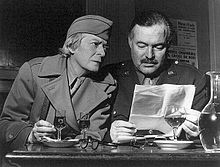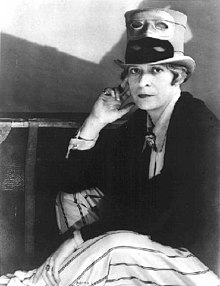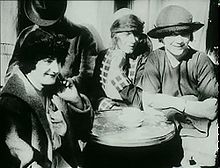Janet Flanner
Janet Tyler Flanner (born March 13, 1892 in Indianapolis , Indiana , † November 7, 1978 in New York City , New York ) was an American writer , journalist and a feminist eccentric .
Life
Janet Flanner was the youngest daughter of Indiana State undertaker and first crematorium owner , Frank Flanner and his wife Mary. Her family belonged to the strict but socially committed Quaker religious community . In 1912 Flanner graduated from the University of Chicago and that same year her father committed suicide. After two years, she dropped out of college to work in a girls' reformatory. In 1916 she returned to her hometown of Indianapolis to work as a journalist for the Indianapolis Star newspaper . In the late 1910s, Janet Flanners fled the community and in 1918 married her former fellow student William Lane Rehm, who had moved to New York after graduation. The couple lived in the bohemian district of Greenwich Village and Flanner quickly made contact with artistic circles and became involved in the women's suffrage movement. At the end of 1919, Janet Flanner had a lesbian love affair with Solita Solano (actually: Sarah Wilkinson), who was a theater critic at the New York Tribune and a freelance writer at the National Geographic Society .
Within a very short time she made the acquaintance of the city's most famous artists, including Dorothy Parker , Robert E. Sherwood , Robert Benchley , Alice Duer Miller , Jane Grant , Ruth Hale , George S. Kaufman , Harold Ross , Neysa McMein , Alexander Woollcott , Franklin Pierce Adams , Edna Ferber , Irving Berlin and Bernard Baruch . She was a frequent guest in their literary circle at the Algonquin Hotel , called the Algonquin Round Table , a loose group of journalists, writers and actors. After separating from her husband (divorced in 1924), she made her way as an actress before finally finding her first job as a journalist in Boston . In 1921 she traveled to Greece and France with her partner . In Paris they soon found their way into the intellectual and lesbian circle around Gertrude Stein , Alice B. Toklas , Natalie Clifford Barney , Romaine Brooks and Djuna Barnes , the circle of friends that would become famous as The Women of the Left Bank . In her letters to Jane Grant, Flanner described the life of artists and intellectuals in Europe in such detail that Grant suggested that her husband publish the letters ( Letter from Paris ) in his new magazine The New Yorker . Under the pseudonym Genêt (French for Janet), she wrote regularly every two weeks from 1925 to 1975 about events in Europe. Among the stories have included descriptions of Ernest Hemingway , F. Scott Fitzgerald , André Gide , Jean-Paul Sartre , Josephine Baker , Pablo Picasso , Igor Fedorovich Stravinsky and the triumphant Atlantic crossing by Charles Lindbergh . In 1931 Flanner traveled to Germany for the first time and reported there under the title About everything, above all, about cultural life in Berlin. In 1936 she reports on the Summer Olympics in Berlin and the political mood in National Socialist Germany . Her summary is: "Only those visitors to this country who absolutely do not want to see or hear anything can escape the signs and signals of the German advance."

In 1932 Flanners had a long affair with the singer Noël Haskins Murphy and lived with her in Passy near Paris. The Ménage à trois lasted until the outbreak of the Second World War, it ended with the escape of Flanner and Solita Solano to New York, where they arrived on October 5, 1939. A year later, at a party in Manhattan , Janet Flanner met 38-year-old Italian Natalia Danesi Murray, who worked as a representative for the Milan-based publisher Arnoldo Mondadori Editore . It was the beginning of a passionate love affair between the two of them; but the relationship with Solita Solano finally broke up. After the liberation by the Allies , she returned to Europe in November 1944 as the official war correspondent on an American army plane . In December 1945 she went to Germany and reported on the Nuremberg Trials for The New Yorker magazine . In the following years she lived again in her adopted home Paris. a. from Rome, Amsterdam, Vienna, Warsaw and various places in Germany. Janet Flanner died at the age of 86 with her family in New York City and was buried on Fire Island .
Awards
- 1947 Knight de Légion d'honneur
- 1958 Honorary Professor at Smith College , Northampton , Massachusetts
- 1959 elected to the American Academy of Arts and Letters
- 1966 National Book Award of Arts and Letters (NBA)
Works (selection)
- The Cubical City. novel
- An American in Paris
- Men and Monuments
- Letter from Paris. New York 1959
- Paris Diary 1945–1965. Claassen Verlag 1967
- Legendary women and a man. Transatlantic portraits. With an afterword by Klaus Blanc. Antje Kunstmann, Munich 1993, ISBN 3-88897-078-4 . Contains a lengthy, critical and malicious essay on Thomas Mann (pp. 53–92)
- Paris, Germany. Reports from Europe 1931–1950. Compiled by Klaus Blanc with photographs by Werner Bischof. Antje Kunstmann, Munich 1992, ISBN 3-88897-059-8
literature
- Maren Gottschalk : The Sharpened Eye - Seven female journalists and their life stories. Beltz and Gelberg, Weinheim 2001, ISBN 3-407-80881-X
- William Murray: Janet, My Mother, and Me. A Memoir of Growing Up With Janet Flanner and Natalia Danesi Murray. Simon & Schuster Books, 2000
- Andrea Weiss: Paris was a woman. The women from the Left Bank. Djuna Barnes, Janet Flanner, Gertrude Stein & Co. reissued. Rowohlt, Reinbek 2006, ISBN 978-3-499-24224-3
- Brenda Wineapple: Genet: A Biography of Janet Flanner. University of Nebraska Press 1992, ISBN 0-8032-9740-8
- Twenty years of Paris . In: Die Zeit , No. 45/1967
Web links
- Janet Flanner in the Internet Movie Database (English)
- Janet Flanner. In: FemBio. Women's biography research (with references and citations).
- Janet Flanner (1892–1978) (English)
Individual evidence
- ↑ Janet Flanner, Paris, Germany ..., p. 19.
- ^ Afterword by Klaus Blanc in: Janet Flanner, Paris, Germany…, pp. 227f.
- ^ Members: Janet Flanner. American Academy of Arts and Letters, accessed March 28, 2019 .
| personal data | |
|---|---|
| SURNAME | Flanner, Janet |
| ALTERNATIVE NAMES | Flanner, Janet Tyler (full name); Genêt (pseudonym) |
| BRIEF DESCRIPTION | American writer, journalist and feminist eccentric |
| DATE OF BIRTH | March 13, 1892 |
| PLACE OF BIRTH | Indianapolis , Indiana |
| DATE OF DEATH | November 7, 1978 |
| Place of death | New York City , New York |

